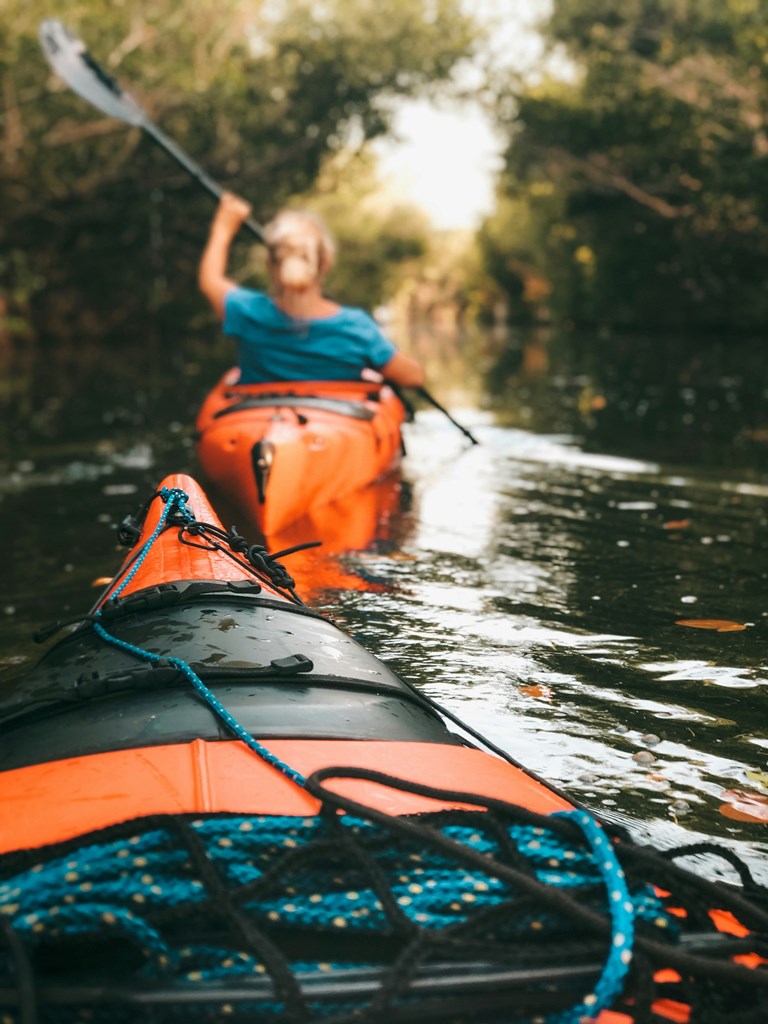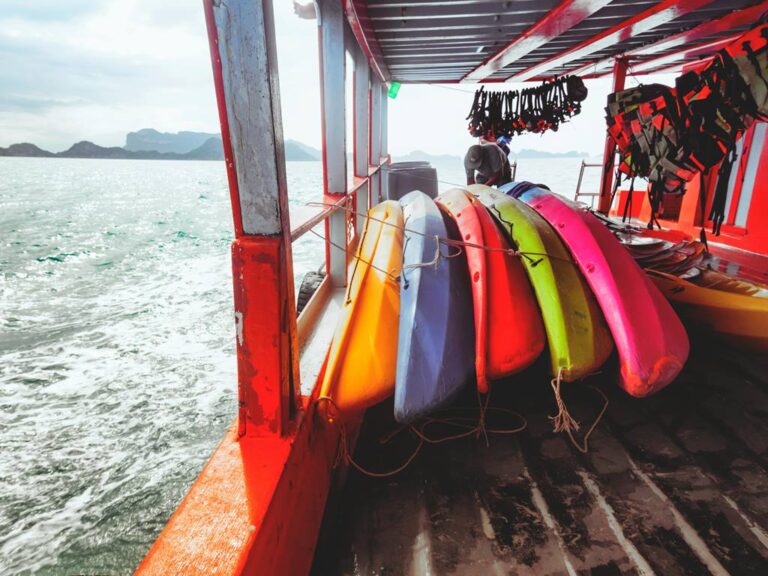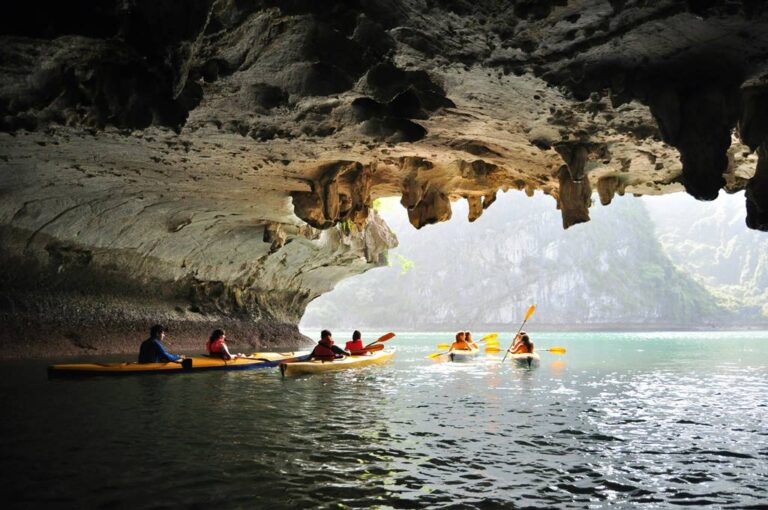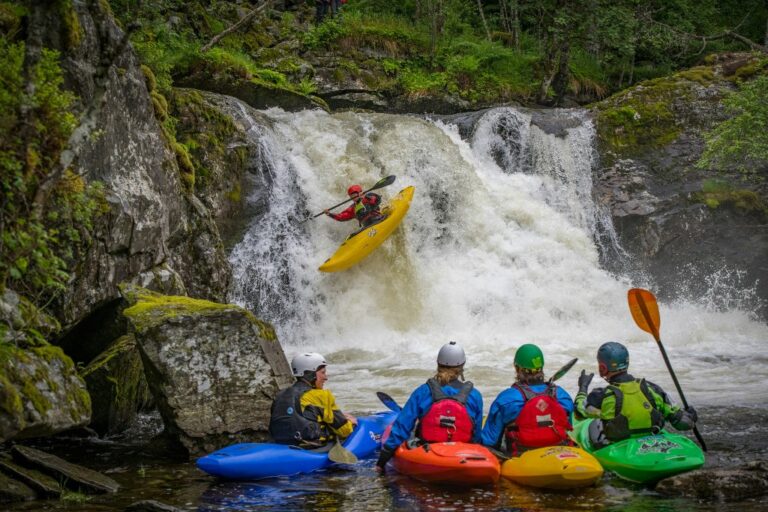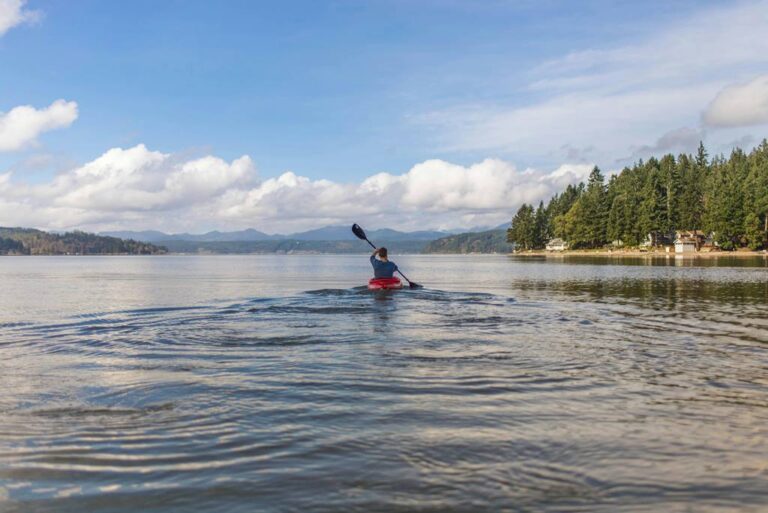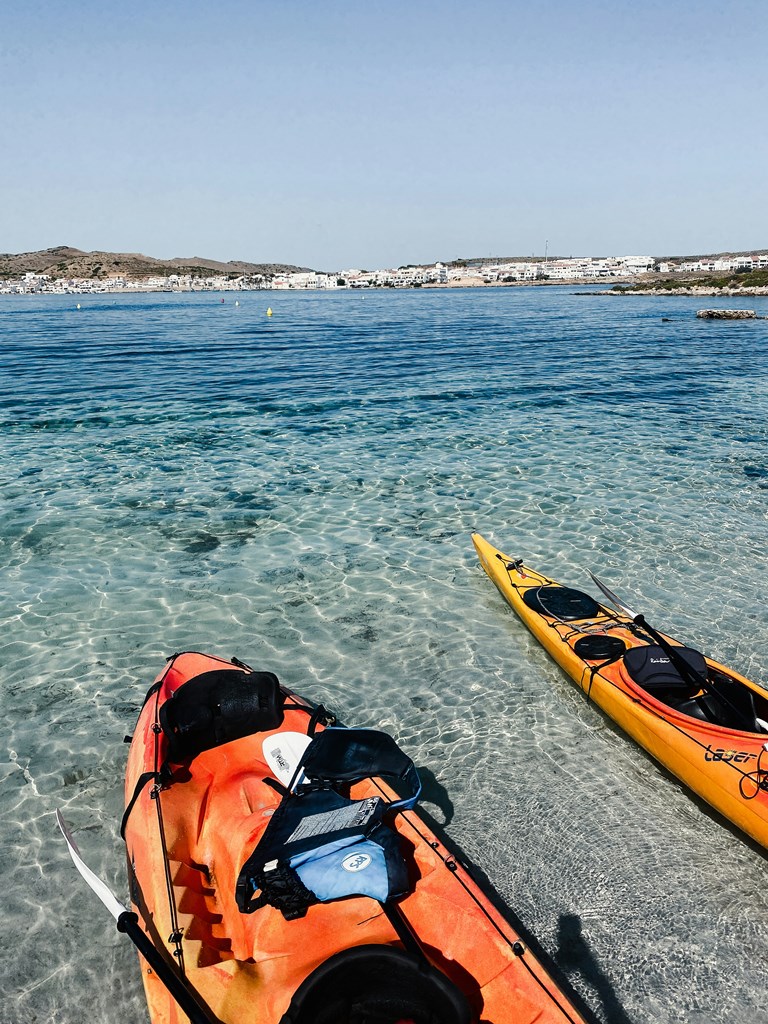
Table of Contents
Dreaming of tranquil journeys across glistening waters? Kayaking for beginners unlocks a world of aquatic exploration. But before setting sail, safety is key. This guide equips you with nine essential tips for a smooth, enjoyable, and most importantly, safe kayaking experience.
1- Pick the Perfect Kayak & Gear
Getting started kayaking is exciting! But before you paddle off, choosing the right kayak and safety gear is key to a fun and safe trip. Here’s a breakdown for beginners:
Finding Your Perfect Kayak
- Sit-on-Top vs. Sit-In: For beginners, a stable sit-on-top kayak is ideal. It’s easy to get in and out of, perfect for calm waters like lakes. Sit-in kayaks are great for longer distances or rougher waters but can be trickier to enter and exit.
- Size Matters: Choose a kayak that’s the right size for you. You should be able to handle it comfortably on land and in the water. Consider weight and length – a shorter kayak is easier to turn, while a longer one tracks straighter.
- Try Before You Buy: Renting different kayaks lets you see which one feels best. This helps you find your perfect fit and paddling style.
Safety Gear Essentials
- Life Jacket (PFD): This is your most important safety item! Choose a well-fitting, comfortable personal flotation device (PFD) approved by Coast Guard regulations.
- Be Heard: Pack a whistle to signal for help in emergencies. Attach it to your PFD for easy access.
- Protect Your Stuff: A waterproof bag keeps your phone, snacks, and other essentials safe from water damage.
Expert Tips:
- Finding the right kayak can take some trial and error. Renting allows you to experiment with different models and paddling styles.
- Comfort is key! Choose a kayak that feels good to sit in and is easy to get in and out of.
- A properly fitted PFD is crucial for safety. It should be snug but comfortable, allowing for movement.
By following these tips, you’ll be well on your way to choosing the perfect kayak and gear for a safe and enjoyable kayaking adventure!
2- Master Basic Paddle Strokes
Learning proper paddling techniques is like learning a secret handshake for the kayaking world. Not only will you look smooth out there, but you’ll also be more in control, less tired, and most importantly, safer! Here’s a breakdown of the key moves to master:
Grip and Posture
- Hold Loose: Grip the paddle with relaxed hands, about shoulder-width apart.
- Bend don’t Break: Keep a slight bend in your elbows for comfort and to avoid straining your arms.
- Sit Tall, Paddle Strong: Sit up straight with good posture and use your core muscles for stability, not just your arms.
Forward Stroke:
- Plant and Pull: Dip the paddle blade in the water near your feet. Use your torso to twist and pull the blade back, not just your arms.
- Switch Sides, Keep Going: When the blade reaches your hip, take it out of the water and switch sides to repeat the stroke.
Reverse Stroke:
- Slow Down or Stop: Need to slow down or stop? Use the reverse stroke! Put the blade in the water behind your hips and push it forward along the side of the kayak. Remember to twist your body with the stroke for more power.
Sweep Stroke:
- Turn Around: The sweep stroke helps you turn. To turn right, reach left, place the blade near the front of the kayak (bow), and sweep it back in a big arc towards the stern (back). Do the opposite to turn left.
Bracing:
- Stay Stable: Bracing helps prevent tipping over. For a low brace, push the paddle blade flat down on the water with your arm extended. For a high brace, raise your arm high and hold the paddle blade like an aeroplane wing.
Support Strokes:
- Manoeuvring Magic: Want to move side-to-side or stay perfectly in place? Sculling strokes use a figure-eight motion with the paddle near the kayak to help with fine-tuned manoeuvring.
Practice Makes Perfect!
Mastering these techniques takes time. Start in calm water and be patient. Consider taking a kayaking class or joining a paddling group for guidance from experienced kayakers.
Expert Tip:
Learning proper paddling techniques can be a game-changer! You’ll be more in control, less tired, and able to explore farther while enjoying the peacefulness of kayaking, not fighting exhaustion.
Master Basic Paddling Techniques
| Technique | Description |
|---|---|
| Forward Stroke | Propel the kayak forward in a straight line by using a continuous stroke on one side. |
| Reverse Stroke | Move the kayak backwards by using a similar stroke on the opposite side. |
| Sweep Stroke | Turn the kayak by sweeping the paddle in a wide arc away from the kayak. |
| Draw Stroke | Move the kayak sideways by pulling the paddle alongside the kayak towards the stern or bow. |
| Rudder Stroke | Use a rudder-like stroke to maintain a straight course in strong crosswinds or currents. |
| Bracing | Keep the kayak stable and prevent capsizing by using a quick downward stroke on the water. |
Now that you’ve got these basic paddling moves down, you’re ready to hit the water with confidence!
3- Check the Weather Forecast & Tides
Whether you’re cruising a calm lake or exploring the coast, checking the weather and tides before you kayak is key for safety and fun. Here’s why it’s important and how to do it:
Weather Wise for Kayaking Safety:
- Safety First: Bad weather can be dangerous! Strong winds, storms, or changing tides can make kayaking tricky. Knowing the forecast helps you avoid these risks and choose a day with calm skies and gentle breezes.
- Paddle in Comfort: Sunshine and calm winds make kayaking more enjoyable! Checking the weather ensures you’ll be comfortable and can focus on the beautiful scenery.
Get the Latest Weather Info:
- National Weather Service: The National Weather Service website or a weather app has the most up-to-date forecasts for your kayaking spot. Look for wind speed, rain chances, and any advisories.
- Local Knowledge: Local weather stations and news can give you even more details about your specific paddling area.
- Wind Maps and Apps: These resources show real-time wind patterns and gusts, helping you avoid strong headwinds or crosswinds that can make paddling difficult.
Tides: Your Kayaking Navigation Guide
- Navigate with Confidence: Tides affect water levels and currents, especially near the coast. Knowing the tide schedule helps you plan your route so you’re not fighting strong currents or stuck in shallow water during low tide.
- Plan Your Adventure: Tides are predictable, so you can plan your kayaking trip with confidence. Knowing high and low tide times lets you explore areas that might be inaccessible at other times.
Find Your Tide Info:
- Tide Charts: Get tide charts for your location from official sources or websites. These charts show high and low tide times, water levels, and tidal range.
- Tide Apps: Many mobile apps offer tide data for your specific location. These can show tide predictions for several days in advance, so you can plan ahead.
Expert Tip:
Always check the weather and tides right before your trip, as they can change quickly. For multi-day adventures, keep checking the forecast and tides throughout your journey.
Remember: According to the US Coast Guard, bad weather is a leading cause of kayaking accidents. Understanding the forecast can significantly reduce your risk and make kayaking safer and more enjoyable. Tides can also affect water levels by several feet, so planning your trip around the tide schedule helps you navigate safely and avoid hazards.
By following these tips, you’ll be well on your way to planning a perfect kayaking adventure with the best weather and tides!
4- Tell Someone Where You’re Going
Letting someone know your kayaking plans is like having a backup buddy on shore. Here’s why it’s important and how to do it:
Be Prepared for Anything:
Accidents can happen. By sharing your trip details, someone on land knows where you are and when to expect you back. If you don’t return on time, they can call for help.
Faster Rescue if Needed:
If you get lost, injured, or stranded, having someone know your itinerary helps search and rescue teams find you faster. The quicker they know where to look, the sooner you’ll be back on dry land.
How to Share Your Kayaking Plans:
- Make a Trip Plan: Before you launch, share a detailed plan with a trusted friend or family member.
- Include Everything: Tell them your starting point, route, estimated start and end time, and any planned stops.
- Share Emergency Contacts: If paddling with others, provide your contact’s name and phone number.
- Waterproof Communication: Bring a fully charged phone in a waterproof case. Let your contact know how to reach you in case of an emergency.
- Check-In and Out: Call your contact to say you’re starting and again when you return safely.
By letting someone know your kayaking plans, you’re adding an extra layer of safety to your paddling adventure. Remember, safety is a team effort, and keeping someone informed can make a big difference!
5- Practice Capsizing & Rescue Skills
While tipping over (capsizing) isn’t what kayakers dream about, being prepared for it can be a lifesaver. Learning how to handle a capsize and get yourself back in your kayak (self-rescue) builds confidence and keeps you safe on the water.
Here’s why it’s important and how to practice:
- Be Ready for Anything: Rough water, wind gusts, or mistakes can all lead to a capsize. Knowing what to do helps you stay calm and take action.
- Be Self-Reliant: Mastering self-rescue techniques lets you get back in your kayak on your own, especially if paddling alone.
Learning the Moves:
- Calm Waters First: Practice capsize drills in a safe, shallow area where you can stand if needed.
- Wet Exit: This is your first step after a capsize. Practice flipping your kayak over and pushing yourself out quickly.
- T-Rescue: Learn this technique to empty water from your kayak and climb back in without help.
- Partner Up: If paddling with others, learn assisted rescue techniques using your buddy’s kayak for stability.
Expert Tip:
Practice capsize drills in a controlled environment before hitting open water. This builds muscle memory and makes the moves more instinctive in an emergency.
My Capsize Story (Mark Miller):
Early on, I capsized during a windy solo paddle. Panic almost took over, but remembering the T-rescue from a kayaking class helped me empty the water and get back in safely. This experience showed me the importance of learning and performing these skills, even when paddling alone.
Navigate Like a Pro: Following the Rules of the Water
Just like on land, there are rules to follow when kayaking to keep everyone safe. Understanding and following these navigation rules prevents accidents and creates a peaceful environment for all.
Why It Matters:
- Avoid Collisions: Waterways can get busy with boats of all sizes. Following the rules helps you navigate safely and avoid crashes.
- Keep Things Smooth: When everyone respects the rules, there’s less confusion and chaos on the water, making it more enjoyable for everyone.
Following the Rules:
- Know Before You Go: Learn the specific navigation rules for the waterway you’ll be paddling on. These rules can vary depending on the location and type of water.
- Right of Way: Bigger boats usually have the right of way over smaller ones like kayaks. Be aware of this to avoid any issues.
- Be Seen: Kayaks are small and easy to miss. Wear bright clothing and consider adding reflective materials to your kayak for better visibility.
- Stay Predictable: Maintain a steady course so other boaters can anticipate your movements. Avoid sudden changes in direction.
- Light Up at Night: If kayaking at night or in low-light conditions, use proper navigation lights on your kayak to help others see you.
By following these tips, you’ll be a prepared and responsible kayaker, ready to conquer the water safely and confidently!
6- Dress for the Water Temperature
While sunshine and warm air might make you want to pack light, dressing for the water temperature is key for safe and comfy kayaking. Water can be much colder than air, and getting soaked can lead to hypothermia, even on a nice day. Here’s why it’s important and what to wear:
Stay Safe and Warm:
- Beat Hypothermia: Hypothermia happens when your body loses heat faster than it can make it, making your body temperature dangerously low. Cold water speeds up heat loss, putting kayakers at risk of hypothermia, which can be deadly.
- Be Prepared for Spills: Even on a sunny day, accidents can happen and leave you in the water. Dressing right lowers your chance of hypothermia and gives you more time to get back in your kayak or wait for help if you tip over.
What to Wear Kayaking:
- Layers are Your Friend: Dress in layers so you can adjust your temperature. Start with a thin, moisture-wicking shirt that pulls sweat away from your skin. Then add an insulating layer like fleece or a special neoprene shirt to trap your body heat. Finally, a waterproof and windproof jacket or shell keeps the elements out.
- Wet or Dry Suit Up: For cold water, consider a wetsuit or dry suit. Wetsuits are made of neoprene, which traps a thin layer of water next to your skin. Your body heat warms this water, keeping you warm. Drysuits are completely waterproof and keep all water out.
- Keep Your Head and Hands Warm: Wear a hat or a neoprene hood to insulate your head, where you lose a lot of heat. Neoprene gloves or mittens protect your hands from the cold water.
- Don’t Forget Your Feet: Wear neoprene booties or waterproof kayaking shoes to keep your feet warm and dry. Skip the cotton socks – they soak up water and make your feet colder.
Expert Tip:
When unsure about what to wear, choose something a bit warmer. It’s easier to take layers off if you get hot, but adding them along the water is tough.
Expert Tip:
The Dangers of Cold Water:
A study by R. Michael Harnett showed cold water is a major cause of boating deaths. The US Coast Guard found that 64% of boating deaths involved cold water immersion. Most of these deaths happened in water below 70 degrees Fahrenheit (21 degrees Celsius). Dressing for cold water can significantly reduce your risk of hypothermia while kayaking.
By following these tips and dressing for the water temperature, you’ll be a safe and comfortable kayaker ready to enjoy your paddling adventure!
7- Stay Hydrated and Fueled
Hitting the water for a kayak adventure is awesome, but staying energized is key! Here’s why hydration and food are important, and how to stay on top of them:
Stay Strong, Paddle Long:
- Fuel Your Fun: Kayaking burns calories, and having the right fuel keeps you paddling strong and enjoying your time on the water.
- Beat the Heat: Paddling under the sun can zap your fluids. Staying hydrated prevents dehydration, which can make you feel tired, weak, and even lead to heatstroke.
Hydration and Food for Kayaking:
- Water is Your Best Friend: Pack plenty of water and sip regularly throughout your trip, even if you don’t feel thirsty. Aim for a few sips every 15-20 minutes.
- Electrolytes for Long Adventures: Consider adding electrolyte tablets or sports drinks to your water on extended trips, especially in hot weather. These help replenish electrolytes lost through sweat.
- Snack Smart: Pack healthy snacks that are easy to eat in your kayak. Fruits, nuts, granola bars, and energy bars are all good options. Avoid sugary snacks that will give you a quick burst of energy followed by a crash
8- Be Mindful of Wildlife and the Environment
Kayaking lets us explore the amazing world of our waterways, but with this privilege comes responsibility. We need to be mindful of the wildlife and environment to keep these special places healthy for everyone. Here’s why it’s important and how to do it:
Protect What You Love:
- Healthy Waterways: Our waterways are like busy neighbourhoods for plants and animals. Being mindful helps us minimize our impact and keep everything in balance.
- Respectful Wildlife Watching: Animals deserve their space. Keep a distance and use zoom lenses for close-up views so they feel safe and stay wild.
Be a Nature Ninja:
- Give Wildlife Space: When paddling near animals, keep a safe distance. This avoids stressing them out and lets them enjoy their natural habitat.
- Don’t Feed the Animals: Just like offering candy to kids, feeding wildlife disrupts their natural way of finding food. It can also be unhealthy for them.
- Pack In, Pack Out: Take all your trash with you and dispose of it properly. Try to avoid single-use plastics and use reusable containers to keep our waterways clean.
- Stick to the Path: If kayaking in wetlands or wildlife areas, follow designated water trails. This helps protect sensitive plants and animals where they live and raise their young.
The Butterfly Effect of Kayaking:
By being mindful, we create a positive ripple effect. When we treat nature with respect, it benefits the whole ecosystem, from tiny fish to majestic birds. We all play a part in keeping our waterways healthy!
Leave No Trace
This means leaving the environment as natural as you found it. No trash, no disruptions, just enjoying the beauty without a trace! By following “Leave No Trace” principles, we ensure wildlife and their habitats remain healthy and undisturbed.
Be a Nature Steward:
By being mindful of your kayaking adventures, you become a protector of the natural world. Remember, the beauty of our waterways depends on keeping them wild. By following these tips, you’ll help preserve these treasures for future kayakers to enjoy!
9- Embrace Safe Kayaking!
Kayaking is awesome! It lets you explore nature, have fun, and find peace on the water. But safety first! Follow these tips for a fantastic kayaking trip:
- Plan Ahead: Check the weather and tides before you go. Let someone know where you’ll be paddling and when you expect to be back.
- Be Prepared: Learn how to handle a capsize (tipping over) and get back in your kayak. Wear clothes that work for the water temperature, not just the air temperature. Follow the rules of the water to avoid bumps with other boats.
- Safety First, Fun Follows: By following these simple rules, you’ll be safe and responsible, setting a good example for other kayakers.
With a little planning and some safety know-how, you can turn every kayaking trip into a memorable adventure. So grab your paddle, hit the water, and enjoy the ride!
Kayaking Frequently Asked Questions:
Hitting the water in a kayak is a fantastic way to explore and enjoy the outdoors. But before you set off, here are some answers to frequently asked questions to ensure a safe and fun kayaking trip:
Q: What safety gear should I bring kayaking?
A: Essentials include a life jacket (PFD), a whistle for signalling, a bilge pump or sponge to remove water from your kayak, and a communication device like a fully charged phone in a waterproof case. These will keep you safe and prepared on the water.
Q: Can I kayak alone, or is it better to go with others?
A: While experienced paddlers can kayak solo, paddling with a group is generally safer, especially for beginners. Having a kayaking buddy provides support in case of emergencies and makes the trip more enjoyable.
Q: How do I check the weather and tides before kayaking?
A: Reliable weather websites, mobile apps, or local weather reports can give you the latest forecast. For tides, check tide charts specific to your paddling location or use online tide prediction tools.
Q: What happens if I capsize (tip over) while kayaking?
A: Stay calm and remember your capsize training! Practice a wet exit (flipping over and pushing yourself out), then use self-rescue or assisted rescue techniques (depending on if you’re paddling with others) to get back in your kayak and continue your adventure.
Q: Are there any rules I need to follow on the water?
A: Absolutely! Navigation rules dictate right-of-way and prevent collisions with other boats. Following these rules keeps everyone safe and ensures a smooth experience for all paddlers.
Q: How should I dress for kayaking in different water temperatures?
A: Layering is key! Wear a moisture-wicking base layer to pull sweat away from your skin. Add an insulating layer like fleece or neoprene for warmth. Top it off with a waterproof and windproof outer layer to keep the elements out. In cold water, consider a wetsuit or dry suit for extra insulation.
By following these tips and asking the right questions, you’re well on your way to a fantastic kayaking adventure!

